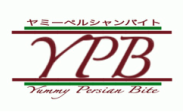About Yummy Persian Bite
日本語
Persian cuisine refers to the traditional and modern style of cooking related to Iran. The Iranian culinary style is unique to Iran, though has historically both influenced and has been influenced by Iran’s neighboring regions at various stages throughout its history.
Generally, in Persian cooking the food is not overpowered with spices. While herbs, spices and sometimes fruits are used for seasoning and garnishing, the flavors are quite rarefied and delicate. Enriched with a colorful and yet healthy diversity of dishes that are peculiar to various regions of this country, Iranian food is highly popular in the east and the west for its freshness and deliciousness.
In Iran, with 12 separate geographic environments and 5 major climates, home to about 8000 species of plants which around 2100 of them have medicinal properties, when it comes to herbs you always have plenty of choices, as fresh green herbs are frequently used along with fruits such as Plums, Pomegranates, Prunes, Apricots and Raisins.
Typical Persian main dishes are the combination of Rice or Bread with Lamb, Chicken or Fish, some Onion, Vegetables, Nuts and Herbs which are commonly served in stews as well as in the form of the popular Kabab. To achieve a balanced taste, characteristic Persian flavorings such as saffron, dried Limes, Cinnamon and Parsley are mixed delicately and used in some special dishes. Many foods famously associated with Western Asia, and indeed some have their origins in Iran, such as Kabab and Ice Cream.
Traditional Persian cuisine is often adjusted to fit Vegetarian demands. Although meat plays an important role in most Persian dishes, it is possible to find excellent Persian vegetarian cooking.
For centuries Iranians have looked at the food in 3 different ways; Medicinal, Philosophical and Cultural. A healthy diet is considered to be the main factor to revive the body and the mind by creating inconceivable powers to make us gentle and noble as individuals and eventually as a society.
Generally, in Persian cooking the food is not overpowered with spices. While herbs, spices and sometimes fruits are used for seasoning and garnishing, the flavors are quite rarefied and delicate. Enriched with a colorful and yet healthy diversity of dishes that are peculiar to various regions of this country, Iranian food is highly popular in the east and the west for its freshness and deliciousness.
In Iran, with 12 separate geographic environments and 5 major climates, home to about 8000 species of plants which around 2100 of them have medicinal properties, when it comes to herbs you always have plenty of choices, as fresh green herbs are frequently used along with fruits such as Plums, Pomegranates, Prunes, Apricots and Raisins.
Typical Persian main dishes are the combination of Rice or Bread with Lamb, Chicken or Fish, some Onion, Vegetables, Nuts and Herbs which are commonly served in stews as well as in the form of the popular Kabab. To achieve a balanced taste, characteristic Persian flavorings such as saffron, dried Limes, Cinnamon and Parsley are mixed delicately and used in some special dishes. Many foods famously associated with Western Asia, and indeed some have their origins in Iran, such as Kabab and Ice Cream.
Traditional Persian cuisine is often adjusted to fit Vegetarian demands. Although meat plays an important role in most Persian dishes, it is possible to find excellent Persian vegetarian cooking.
For centuries Iranians have looked at the food in 3 different ways; Medicinal, Philosophical and Cultural. A healthy diet is considered to be the main factor to revive the body and the mind by creating inconceivable powers to make us gentle and noble as individuals and eventually as a society.

Although during my school years I helped my mother in the kitchen by peeling, cutting …, while she was cooking, but never paid enough attention to learn how to cook the whole food from scratch till it’s done, because I never had to.
Not knowing how to cook sometimes was making my early years of stay in Japan uncomfortable. For many years I enjoyed eating Persian foods cooked by my mother and sisters, but now I had to endure the task. In Japanese busy lifestyle and having a hectic daily schedule, the challenge of cooking seemed a time consuming task and perhaps a little intimidating of a venture.
Like many other cultures, there is a variety of tasty dishes on Persian cuisine menu, but one thing is for sure; there isn’t such a thing as “fast food or fast cooking” in Persian cooking. Usually all dishes consist of all of the food groups and it requires time, patience and special attention or “love” as it is being called by the cooks in this culture.
The Persian style of cooking is “Aromatic”, where for instance, for Persian stew we first sweat the ingredients, herbs and spices in different order to develop smell and taste to the desired effect, then add the water or stock to the stew.
For a while I was thinking that this style of cooking doesn’t really suit the Japanese busy lifestyle. However, on occasions of talking to my mother and sisters on the phone, I began asking about the recipe of the foods that I didn’t have for a long time. Since cooking Persian dishes in the traditional way is a luxury that not everyone has, I had to simplify the recipes to be able to cook without losing the real tastes, smells or qualities as much as possible.
The outcome of this experience is what I want to share with those who are in the same situation that I was, which is; “How to cook Persian food in a few easy steps”. The directions are written in such details to make it entirely intelligible for everyone, especially for those who want to cook for the first time. Easy to follow and cook confidently, Keeping in mind that according to your desires, you can increase or decrease the amount of the ingredients. Everyone deserves to have a delicious, warm homemade food at least on weekends, if not every day. Once you learn the basics, using similar concept but different preferences, you can literally make hundreds of delicious dishes.
Nutrition and wellness are intricately inter-linked. The kind of food we consume specially at earlier age, sets in the metabolism pace of our body for the rest of our life.
Being involved in maintaining and improving people’s health by providing advice and information as a pharmacist for over five years in Iran, I am convinced that conventional medicine is necessary at certain juncture of treatments, but I believe by making better dietary choices we may never come across those junctures needing any modern medicine.
What we eat and how we eat matters, as it determines what our body is composed of and how our body works. The conditions of our body are largely related to the nutritional choices we make. If we want to live a better life, we have to take time to plan out what we are going to eat. It is a very important part of our life.
Persian cuisine offers a collection of the most refined delicacies. They are a feast to the eyes, not just because of their color and flavor, but for their unique nutrition profile that help the body to stay healthy. Yummy Persian Bite is a showcase of this rich aspect of Iranian heritage.
Hamid
22/02/2014
Not knowing how to cook sometimes was making my early years of stay in Japan uncomfortable. For many years I enjoyed eating Persian foods cooked by my mother and sisters, but now I had to endure the task. In Japanese busy lifestyle and having a hectic daily schedule, the challenge of cooking seemed a time consuming task and perhaps a little intimidating of a venture.
Like many other cultures, there is a variety of tasty dishes on Persian cuisine menu, but one thing is for sure; there isn’t such a thing as “fast food or fast cooking” in Persian cooking. Usually all dishes consist of all of the food groups and it requires time, patience and special attention or “love” as it is being called by the cooks in this culture.
The Persian style of cooking is “Aromatic”, where for instance, for Persian stew we first sweat the ingredients, herbs and spices in different order to develop smell and taste to the desired effect, then add the water or stock to the stew.
For a while I was thinking that this style of cooking doesn’t really suit the Japanese busy lifestyle. However, on occasions of talking to my mother and sisters on the phone, I began asking about the recipe of the foods that I didn’t have for a long time. Since cooking Persian dishes in the traditional way is a luxury that not everyone has, I had to simplify the recipes to be able to cook without losing the real tastes, smells or qualities as much as possible.
The outcome of this experience is what I want to share with those who are in the same situation that I was, which is; “How to cook Persian food in a few easy steps”. The directions are written in such details to make it entirely intelligible for everyone, especially for those who want to cook for the first time. Easy to follow and cook confidently, Keeping in mind that according to your desires, you can increase or decrease the amount of the ingredients. Everyone deserves to have a delicious, warm homemade food at least on weekends, if not every day. Once you learn the basics, using similar concept but different preferences, you can literally make hundreds of delicious dishes.
Nutrition and wellness are intricately inter-linked. The kind of food we consume specially at earlier age, sets in the metabolism pace of our body for the rest of our life.
Being involved in maintaining and improving people’s health by providing advice and information as a pharmacist for over five years in Iran, I am convinced that conventional medicine is necessary at certain juncture of treatments, but I believe by making better dietary choices we may never come across those junctures needing any modern medicine.
What we eat and how we eat matters, as it determines what our body is composed of and how our body works. The conditions of our body are largely related to the nutritional choices we make. If we want to live a better life, we have to take time to plan out what we are going to eat. It is a very important part of our life.
Persian cuisine offers a collection of the most refined delicacies. They are a feast to the eyes, not just because of their color and flavor, but for their unique nutrition profile that help the body to stay healthy. Yummy Persian Bite is a showcase of this rich aspect of Iranian heritage.
Hamid
22/02/2014

